
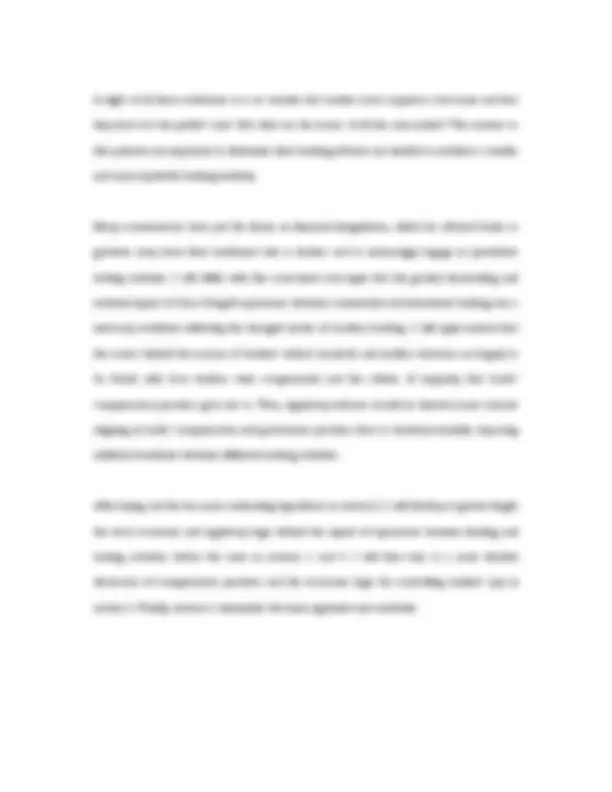
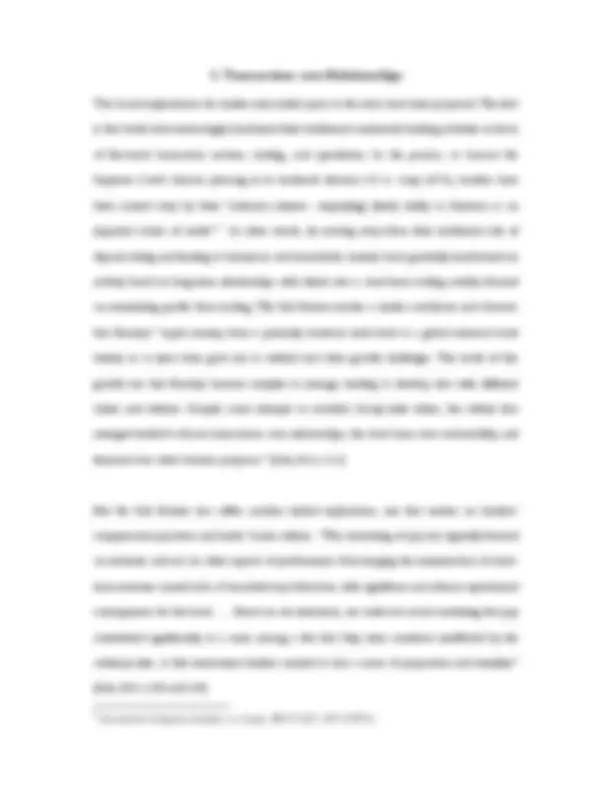
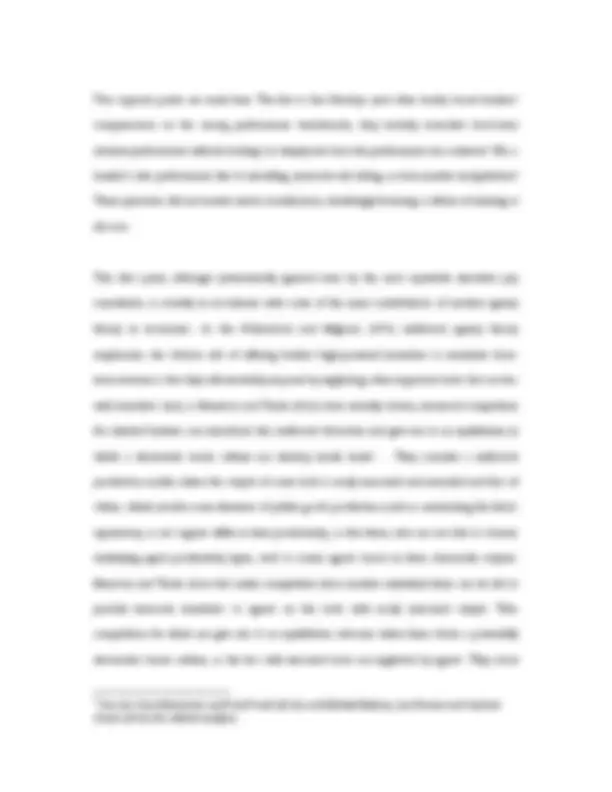
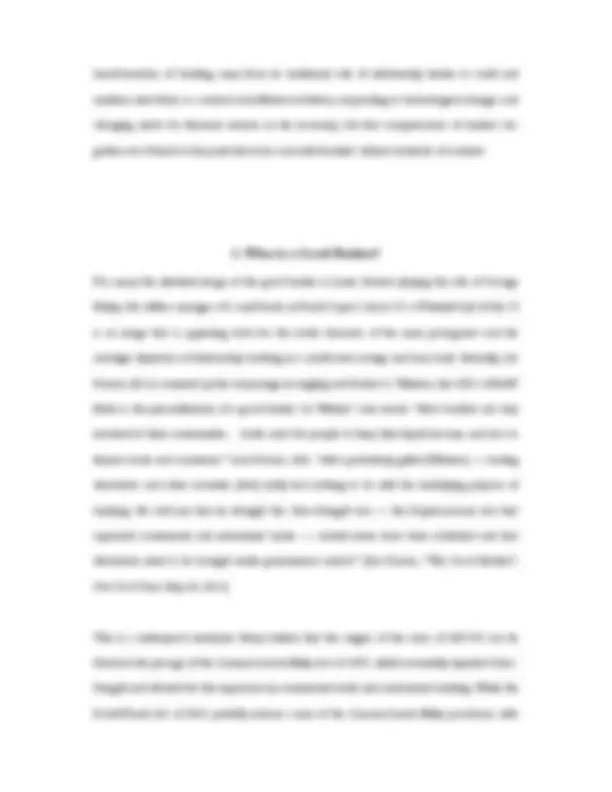
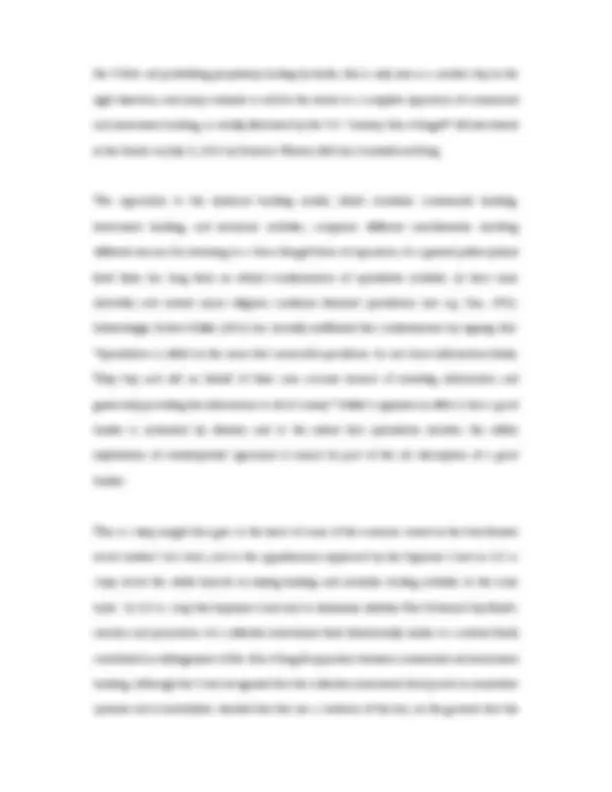
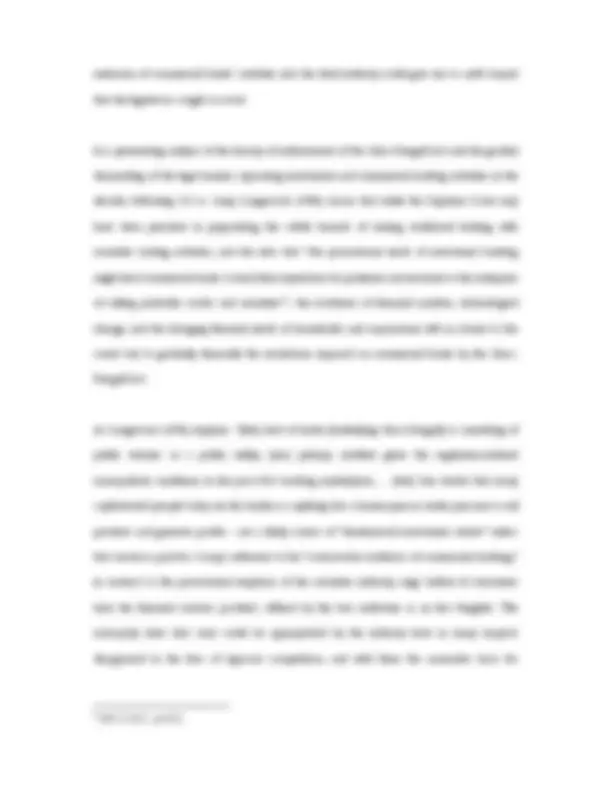
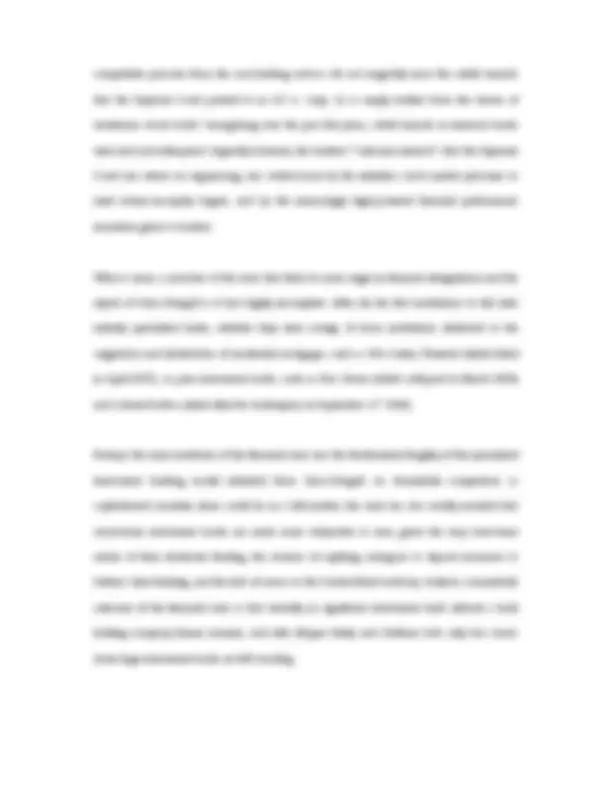
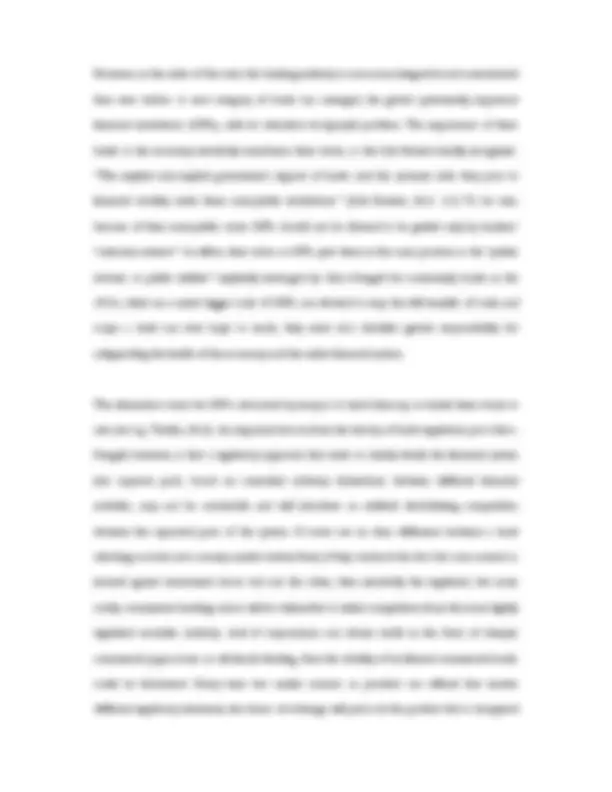
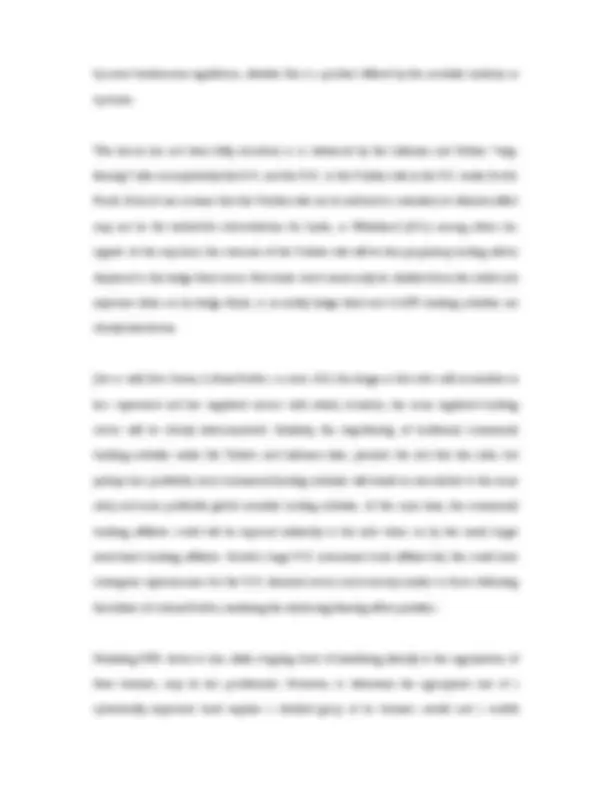
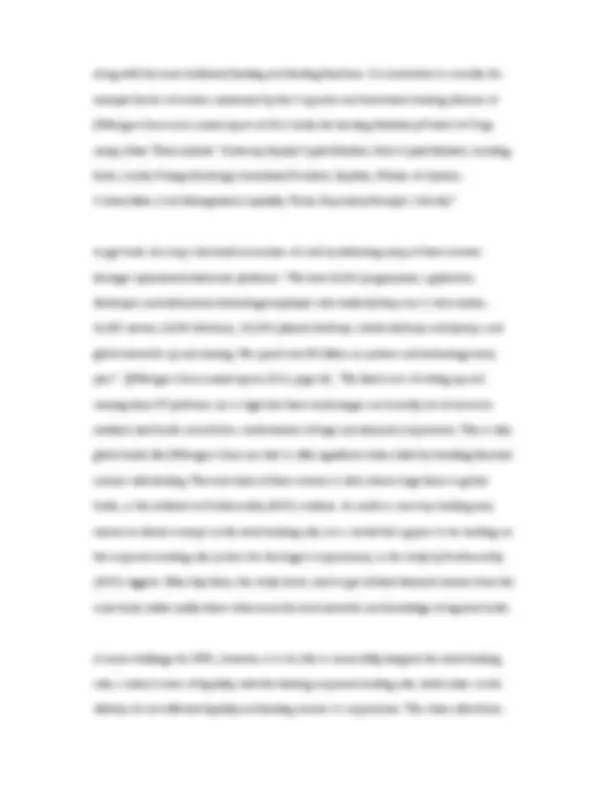
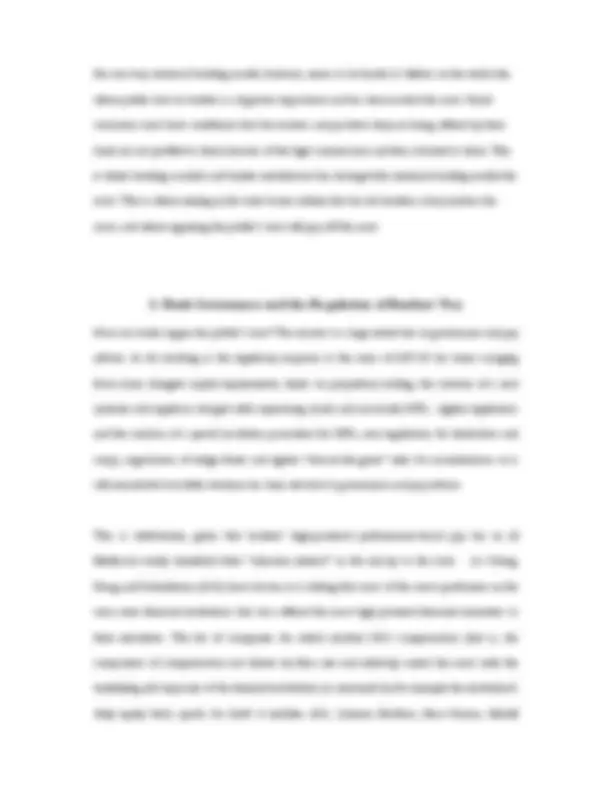
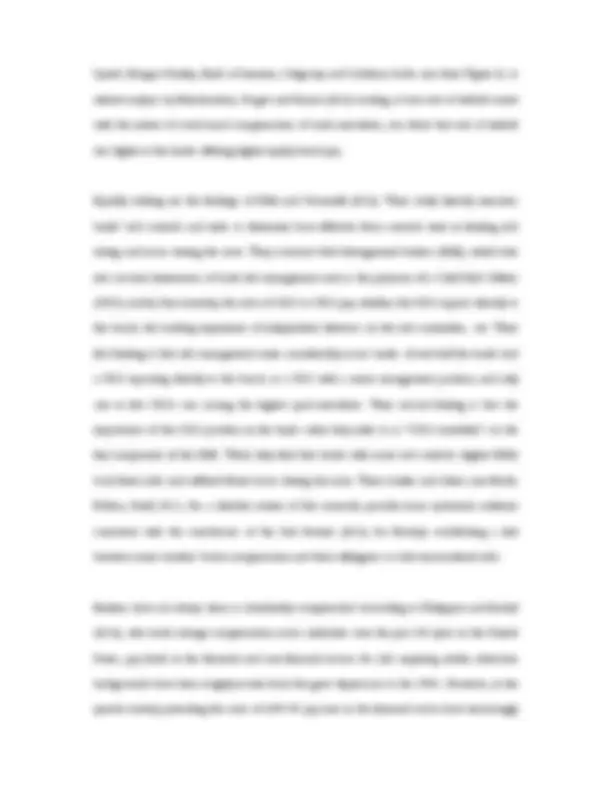
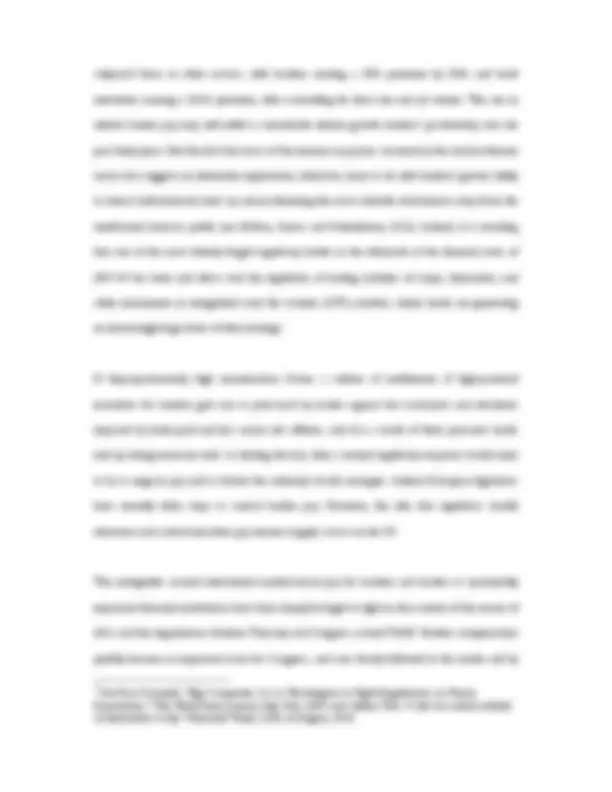
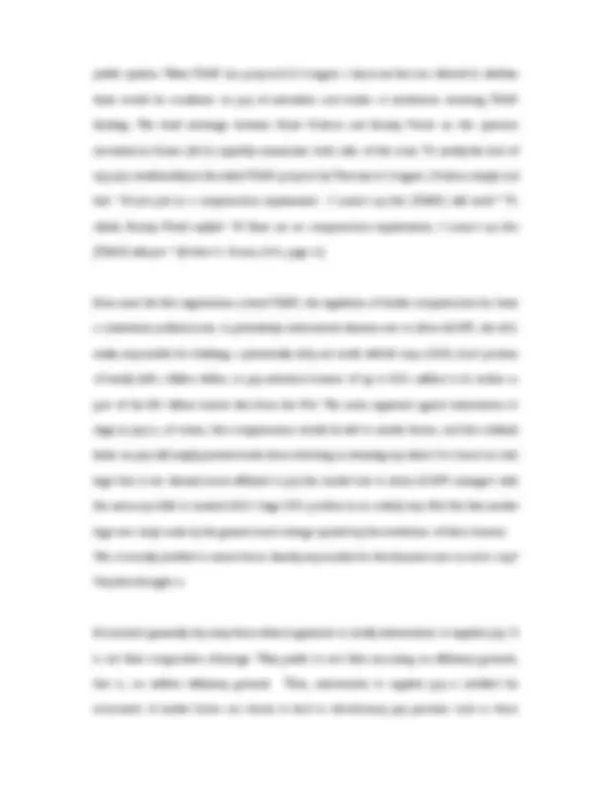
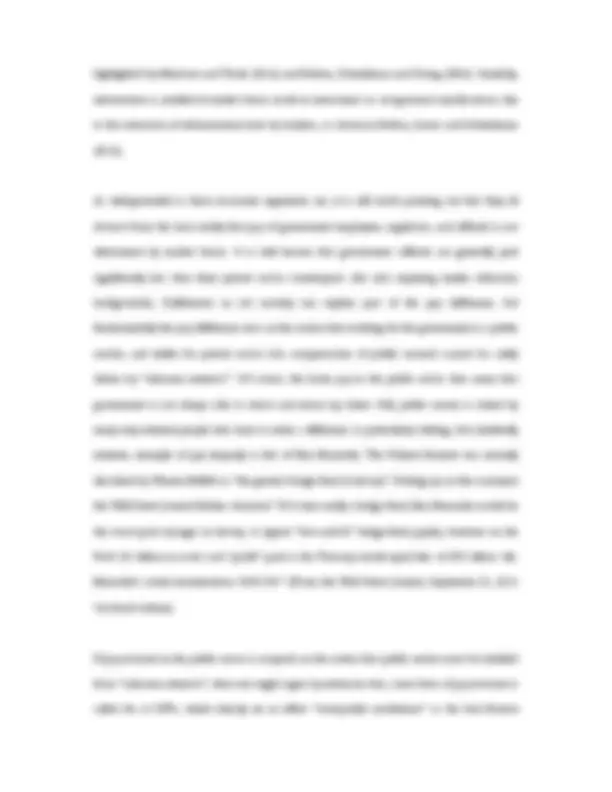
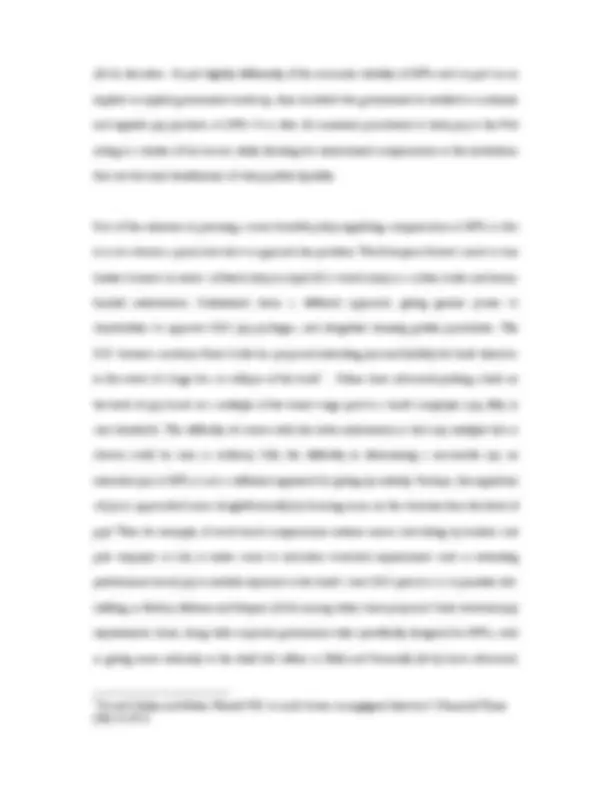
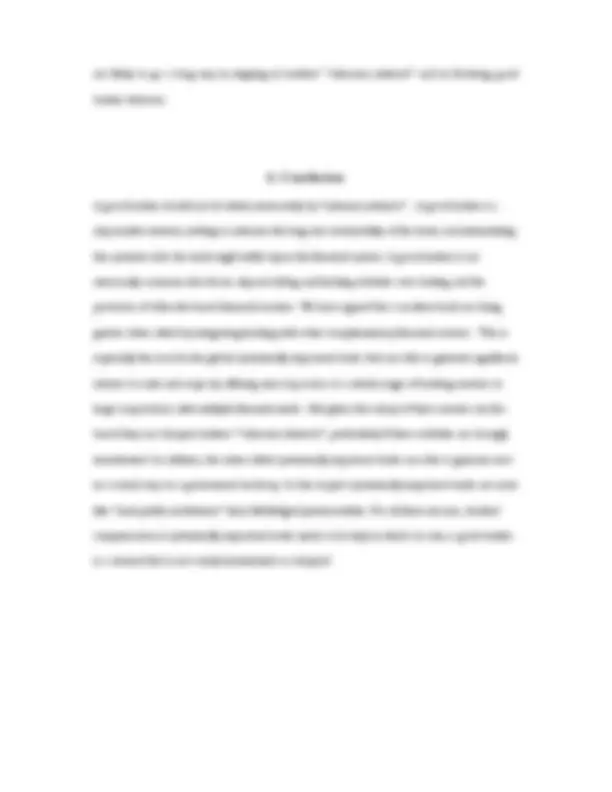
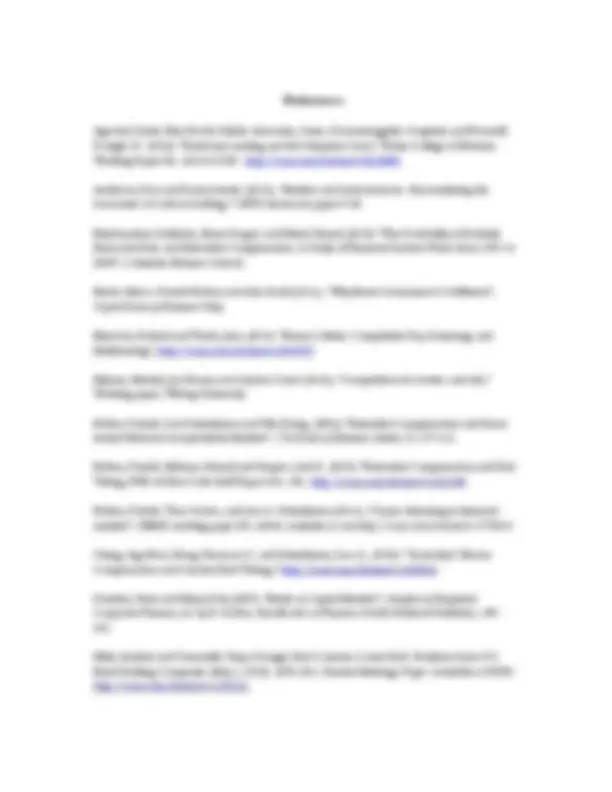
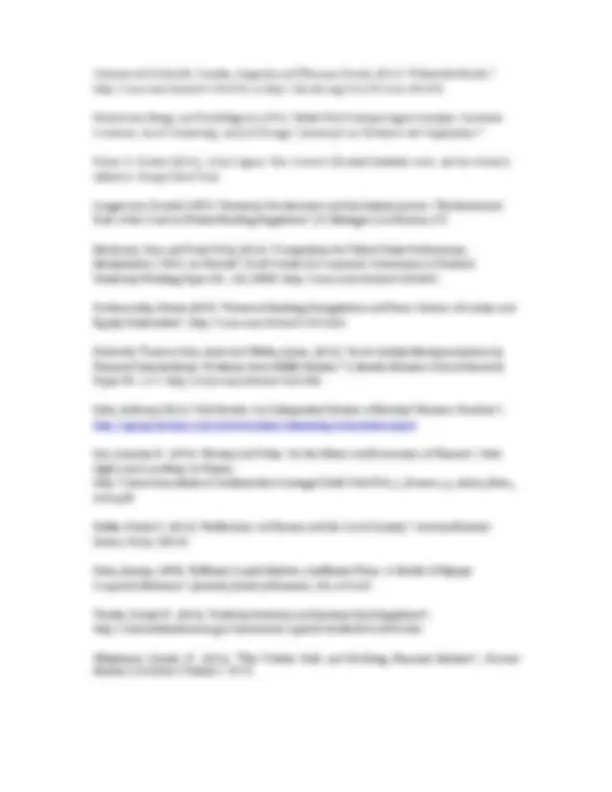


Study with the several resources on Docsity

Earn points by helping other students or get them with a premium plan


Prepare for your exams
Study with the several resources on Docsity

Earn points to download
Earn points by helping other students or get them with a premium plan
Community
Ask the community for help and clear up your study doubts
Discover the best universities in your country according to Docsity users
Free resources
Download our free guides on studying techniques, anxiety management strategies, and thesis advice from Docsity tutors
The role of banks in modern economies, focusing on trading activities and their impact on banks' traditional lending role. The author argues that trading activities are an integral and desirable part of modern banking and enhance banks' traditional lending role. The document also discusses the concerns about 'too-big-to-fail' banks and the economic benefits of banks' non-lending activities. The author suggests that the main cause of bankers' reckless behavior is out of hand compensation practices.
Typology: Essays (university)
1 / 27

This page cannot be seen from the preview
Don't miss anything!




















Patrick Bolton Columbia University, ECGI, CEPR and NBER
Second Draft: November 4, 2013
What is a good banker? What is the economic value added of banks? The economics literatureon financial intermediation focuses on the role of banks as deposit-taking institutions and as delegated monitors of borrowers. But this description barely begins to represent what banks do in a modern economy. Besides commercial lending, large banks are engaged in a number ofother activities ranging from cash management, trade credit, swaps and derivatives trading and underwriting of securities. In recent decades banks have increasingly relied on fee income generated from their activities other than lending. The financial crisis, and the concerns about“too-big-to-fail” banks it has exposed, has led to a re-evaluation of bankers’ speculative practices and of the economic benefits of banks’ non-lending activities. Do trading activities undermine sound banking principles and core lending functions? Do they provide economic benefits, or are they simply an undesirable side-product of deregulation? The main argument of this article isthat trading activities are an integral and desirable part of modern banking. These activities enhance banks’ traditional lending role, and regulatory attempts to separate lending and non- lending activities are mostly counterproductive. The main cause of bankers’ reckless behavior israther to be found in out of hand compensation practices, which exacerbate bankers’ pursuit of short-run profit opportunities at the expense of financial stability and their clients’ interests.
(^1) I am grateful to Edward Glaeser, Jeffrey Gordon, Ailsa Röell, Charles Sabel, Tano Santos and Glen Weyl for helpful conversations and comments.
The Libor scandal prompted the new management of Barclays to commission an in-depth review of the bank’s corporate culture by an independent commission headed by Anthony Salz. Following extensive internal interviews with hundreds of Barclays’ bankers a detailed and insightful review of Barclays’ management failings was published in April 2013. It begins with a tactful British understatement: “The public has been encouraged by politicians, regulators and the media to see the banks as having a significant responsibility for the financial crisis and the ensuing economic ills. This has been a cause of the loss of public confidence.” [Salz Review, page 4, paragraph 2.5]. To be sure, there has been a constant outpouring of negative commentary on bankers’ ethical blindness ever since the failure of Bear Stearns , fuelled by a seemingly endless stream of revelations about banks’ dubious practices before and during the financial crisis.
We thought we had heard the worst about banks’ misconduct, when shady mortgage origination practices—epitomized by predatory lending methods and the rapid growth of ‘Ninja’^2 Loans— were reported, or when later the widespread misselling of mortgage-backed securities was uncovered^3. Alas, over the past five years we have learnt that virtually every major bank has been involved in some form of malfeasance, and that essentially every banking activity has been touched by some scandal, whether it was improperly feeding funds to Bernie Madoff, money laundering, facilitating tax evasion for wealthy private clients, collusion in credit derivatives markets, or the manipulation of LIBOR. What is worse, some banks seemed to continue their bad habits undeterred during the crisis, as the robo-signing of foreclosure notices scandal revealed.
(^2) See for example Agarwal et al. (2012); Ninja stands for “no income, no job and no assets”. (^3) See for example Piskorski et al. (2013).
Two broad explanations for banker misconduct prior to the crisis have been proposed. The first is that banks have increasingly abandoned their traditional commercial banking activities in favor of fee-based transaction services, trading, and speculation. In the process, to borrow the Supreme Court’s famous phrasing in its landmark decision ICI vs. Camp (1971), bankers have been carried away by their “salesman interest…impair[ing] [their] ability to function as an impartial source of credit.”^4 In other words, by moving away from their traditional role of deposit taking and lending to businesses and households, bankers have gradually transformed an activity based on long-term relationships with clients into a short-term trading activity focused on maximizing profits from trading. The Salz Review reaches a similar conclusion and observes that Barclays’ “rapid journey, from a primarily domestic retail bank to a global universal bank twenty or so years later, gave rise to cultural and other growth challenges. The result of this growth was that Barclays became complex to manage, tending to develop silos with different values and cultures. Despite some attempts to establish Group-wide values, the culture that emerged tended to favour transactions over relationships, the short term over sustainability, and financial over other business purposes.” [Salz, 2013, 2.13]
But the Salz Review also offers another related explanation, one that centers on bankers’ compensation practices and banks’ bonus culture: “The structuring of pay was typically focused on revenues and not on other aspects of performance. Encouraging the maximisation of short- term revenues carried risks of unsatisfactory behaviour, with significant and adverse reputational consequences for the bank...…. Based on our interviews, we could not avoid concluding that pay contributed significantly to a sense among a few that they were somehow unaffected by the ordinary rules. A few investment bankers seemed to lose a sense of proportion and humility.” [Salz, 2013, 2.28 and 2.29] (^4) Investment Company Institute vs. Camp, 401 U.S.C. 617 (1971).
Two separate points are made here. The first is that Barclays (and other banks) based bankers’ compensation on the wrong performance benchmarks; they lavishly rewarded short-term revenue performance without looking too deeply into how the performance was achieved. Was a banker’s sales performance due to misselling, excessive risk taking, or even market manipulation? These questions did not receive much consideration, unwittingly fostering a culture of winning at all costs.
This first point, although systematically ignored even by the most reputable executive pay consultants, is actually in accordance with some of the main contributions of modern agency theory in economics. As the Holmström and Milgrom (1991) multi-task agency theory emphasizes, the obvious risk of offering bankers high-powered incentives to maximize short- term revenue is that they will inevitably respond by neglecting other important tasks that are less well rewarded. And, as Bénabou and Tirole (2012) have recently shown, increased competition for talented bankers can exacerbate this multi-task distortion and give rise to an equilibrium in which a destructive bonus culture can develop inside banks^5. They consider a multi-task production model, where the output of some tasks is easily measured and rewarded and that of others, which involve some elements of public goods production (such as maintaining the firm’s reputation), is not. Agents differ in their productivity, so that firms, who are not able to observe underlying agent productivity types, seek to screen agents based on their observable outputs. Bénabou and Tirole show that under competitive labor markets individual firms can be led to provide excessive incentives to agents on the tasks with easily measured output. Thus competition for talent can give rise to an equilibrium outcome where firms foster a potentially destructive bonus culture, as the less well measured tasks are neglected by agents. They show
(^5) See also Ivan Marinovic and Paul Povel (2012) and Michiel Bijlsma, Jan Boone and Gijsbert Zwart (2012) for related analyses.
theory of incentives that frames compensation practice, especially in view of the abundant anecdotal evidence that people who have the good fortune to rapidly amass wealth can easily become disoriented and squander it, be they successful sportsmen, artists, gamblers, or bankers.
The two broad explanations for the corrosion of bankers’ ethical standards and banker misconduct: i) the shift towards a transactions, fee-based, banking model, and ii) the growth of a toxic bonus culture, are not mutually exclusive. Indeed, many commentators have conflated the two explanations. A prominent example is Simon Johnson, who asserted that: “…the culture in big Wall Street banks remains just as bad as ever — traders and executives have no respect for their clients and are mostly looking for ways to behave badly (and get away with it)…. Top people at megabanks make a lot of money under existing arrangements. They get the upside from big bets and, when things go badly, they benefit from downside protection provided by the government. This amounts to a non-transparent, unfair and dangerous subsidy system. The Volcker Rule will curtail subsidies and cut bankers’ pay…. You should be careful with your investments and be very skeptical of the advice you receive from big banks. Trust community savings banks and credit unions. Trust the FDIC to protect your deposits. Support politicians who want to reform and rein in the power of the big banks.” [Simon Johnson on “Making Banks Play Fair” March 19, 2012; BillMoyers.com]
It is important, however, to make a clear distinction between these two explanations, for they lead to very different assessments of how banking needs to be reformed. Echoing Robert Shiller (2013), who in his discussion of collateralized mortgage obligations (CMOs), wisely warns that: “[we] have to understand human behavior and human ethical standards, to know that the financial system that produced the CMOs and other derivatives was not inherently evil, that it had sound concepts that might sometimes be derailed, that [we] should not adopt a Manichean view of business that sees the financial community in black and white [emphasis added]”, I shall argue that the
transformation of banking away from its traditional role of relationship lender to small and medium sized firms is a natural and efficient evolution, responding to technological changes and changing needs for financial services in the economy, but that compensation of bankers has gotten out of hand to the point that it has corroded bankers’ ethical standards of conduct.
For many the idealized image of the good banker is James Stewart playing the role of George Bailey, the selfless manager of a small bank, in Frank Capra’s classic It’s a Wonderful Life (1946). It is an image that is appealing both for the noble character of the main protagonist and the nostalgic depiction of relationship banking in a small-town savings and loan bank. Recently, Joe Nocera (2011) conjured up this very image in singling out Robert G. Wilmers, the CEO of M&T Bank as the personification of a good banker. In Wilmers’ own words: “Most bankers are very involved in their communities… banks exist for people to keep their liquid income, and also to finance trade and commerce.” And Nocera adds: “what particularly galled [Wilmers] — trading derivatives and other securities [that] really had nothing to do with the underlying purpose of banking. He told me that he thought the Glass-Steagall Act — the Depression-era law that separated commercial and investment banks — should never have been abolished and that derivatives need to be brought under government control.” [Joe Nocera, “The Good Banker”, New York Times, May 30, 2011]
This is a widespread sentiment. Many believe that the origins of the crisis of 2007-09 can be found in the passage of the Gramm–Leach–Bliley Act of 1999, which essentially repealed Glass- Steagall and allowed for the expansion by commercial banks into investment banking. While the Dodd-Frank Act of 2010 partially reverses some of the Gramm–Leach–Bliley provisions with
extension of commercial banks’ activities into the fund industry could give rise to subtle hazards that the legislators sought to avoid.
In a penetrating analysis of the history of enforcement of the Glass-Steagall Act and the gradual dismantling of the legal barriers separating investment and commercial banking activities in the decades following ICI vs. Camp , Langevoort (1986) shows that while the Supreme Court may have been prescient in pinpointing the subtle hazards of mixing traditional lending with securities trading activities, and the risks that “the promotional needs of investment banking might lead commercial banks to lend their reputation for prudence and restraint to the enterprise of selling particular stocks and securities”^6 , the evolution of financial markets, technological change, and the changing financial needs of households and corporations left no choice to the courts but to gradually dismantle the restrictions imposed on commercial banks by the Glass- Steagall Act.
As Langevoort (1986) explains: “[the] view of banks [underlying Glass-Steagall] as something of public trustees or a public utility, [was] perhaps justified given the regulation-induced monopolistic conditions in the post-1933 banking marketplace,…. [but] One doubts that many sophisticated people today see the banker as anything but a businessperson under pressure to sell products and generate profits - not a likely source of “disinterested investment advice” unless that service is paid for. Camp's reference to the “conservative traditions of commercial banking,” in contrast to the promotional emphasis of the securities industry, rings hollow if consumers treat the financial services products offered by the two industries as in fact fungible. The monopoly rents that once could be appropriated by the industry have in many respects disappeared in the face of vigorous competition, and with them the normative basis for
(^6) 401 U.S.C. at 632.
expecting any compensating sense of public responsibility.” [Langevoort, 1986, pages 700 and 703-04]
Indeed, the history of banking of the past fifty years is one of increased competition from the financial services industry, which gradually undermined the traditional, local, undiversified commercial banking model. Whether on the depositor side or on the borrower side, commercial banks increasingly faced competition from close substitutes offered by non-bank entities. When bank depositors moved more and more of their savings into higher-return money market mutual funds, which simultaneously attracted a larger and larger fraction of corporate issuers away from banks, Congress had little choice but to significantly relax the interest rate ceiling restrictions imposed on commercial banks under regulation Q in the early 1980s.
A further relaxation of the commercial banking regulatory straitjacket followed when commercial banks were allowed to offer discount brokerage services and individual retirement accounts (IRAs) to their depositor clients. While the Supreme Court had adhered to a strict interpretation of Glass-Steagall in the early 1970s in ICI vs. Camp , both it and the lower courts gradually retreated from this fundamentalist interpretation in the 1980s and ruled that the provision of these services was not incompatible with Glass-Steagall. Further erosion of the strict separation between securities markets and commercial banking was brought about when securities firms in the mutual funds business were allowed to also offer FDIC-insured checking accounts to their clients, when banks were permitted to privately place commercial paper for their corporate clients, and finally when securities affiliates of bank holding companies were allowed to underwrite stock and bond issues.
In sum, the erosion of the strict separation of lending and trading activities in the 1980s and 1990s took both the form of commercial banks extending their footprint into among others the
competitive pressure from the non-banking sector—do not magically erase the subtle hazards that the Supreme Court pointed to in ICI vs. Camp. As is amply evident from the stream of revelations about banks’ wrongdoing over the past five years, subtle hazards in universal banks were real and widespread. Arguably however, the bankers’ “salesman interest”, that the Supreme Court was intent on suppressing, was stoked more by the relentless stock market pressures to meet return-on-equity targets, and by the increasingly high-powered financial performance incentives given to bankers.
What is more, a narrative of the crisis that finds its main origin in financial deregulation and the repeal of Glass-Steagall is at best highly incomplete. After all, the first institutions to fail were entirely specialized banks, whether they were savings & loans institutions dedicated to the origination and distribution of residential mortgages, such as New Century Financial (which failed in April 2007), or pure investment banks, such as Bear Stearns (which collapsed in March 2008) and Lehman Brothers (which filed for bankruptcy on September 15th^ 2008).
Perhaps the main revelation of the financial crisis was the fundamental fragility of the specialized investment banking model inherited from Glass-Steagall. As formidable competitors as sophisticated securities firms could be in a bull market, the crisis has also starkly revealed that stand-alone investment banks are much more vulnerable to runs, given the very short-term nature of their wholesale funding, the absence of anything analogous to deposit insurance to buttress their funding, and the lack of access to the Central Bank backstop. Indeed, a remarkable outcome of the financial crisis is that virtually no significant investment bank without a bank holding company license remains; and with Morgan Stanley and Goldman Sachs only two stand- alone large investment banks are left standing.
However, in the wake of the crisis the banking industry is now more integrated and concentrated than ever before. A new category of banks has emerged, the global systemically important financial institutions (SIFIs), with its attendant too-big-to-fail problem. The importance of these banks to the economy inevitably transforms their status, as the Salz Review lucidly recognizes: “The implicit and explicit government support of banks and the systemic risks they pose to financial stability make them semi-public institutions.” [Salz Review, 2013: 2.5] To be sure, because of their semi-public status SIFIs should not be allowed to be guided only by bankers’ “salesman interest”. In effect, their status as SIFIs puts them in the same position as the “public trustees or public utilities” implicitly envisaged by Glass-Steagall for community banks in the 1930s, albeit on a much bigger scale. If SIFIs are allowed to reap the full benefits of scale and scope a bank can ever hope to reach, they must also shoulder greater responsibility for safeguarding the health of the economy and the entire financial system.
The alternative course for SIFIs advocated by many is to break them up or shrink them down to size (see e.g. Tarullo, 2012). An important lesson from the history of bank regulation post-Glass- Steagall, however, is that a regulatory approach that seeks to strictly divide the financial system into separate parts, based on somewhat arbitrary distinctions between different financial activities, may not be sustainable and will introduce an artificial destabilizing competition between the separated parts of the system. If savers see no clear difference between a bank checking account and a money market mutual fund, if they overlook the fact that one contract is insured against investment losses but not the other, then inevitably the regulated, but more costly, commercial banking sector will be vulnerable to unfair competition from the more lightly regulated securities industry. And if corporations can obtain credit in the form of cheaper commercial paper issues or wholesale funding, then the viability of traditional commercial banks could be threatened. Every time two similar services or products are offered that receive different regulatory treatment, the forces of arbitrage will push out the product that is hampered
evaluation of the source of its returns to scale and scope. Measuring bank returns to scale is an even more perilous exercise than for non-financial firms. In particular, the estimated size of returns to scale can vary dramatically depending on how financial and human capital is measured, and on whether the measured producer surplus does or does not include bankers’ (abnormal) compensation, as Anderson and Joeveer (2013) have shown. Moreover, limiting the size of G- SIFIs may not necessarily reduce systemic risk: if the smaller G-SIFIs have similar balance sheets then an aggregate shock to a particular asset class can result in similar destabilizing fire-sale externalities as when a large horizontally integrated G-SIFI holds the same positions, as Greenwood, Landier and Thesmar (2011) have shown.
What is the source of returns to scale and scope of large systemically important financial institutions? What economic value added do these banks contribute to the economy? How SIFIs should be regulated and whether they should be barred from investment banking activities or proprietary trading depends in large part on the answer to these questions. Unfortunately, there is little existing research in finance and economics on bank returns to scale and scope we can rely on. First of all, only a tiny fraction of the academic research literature on banking is devoted to universal banks (see Drucker and Puri, 2007 for a recent survey). Second, the literature on universal banks mostly focuses on the narrow issue of the costs and benefits of combining underwriting services and lending activities in the same institution. Indeed, most of the theoretical literature on universal banks is cast around the following tradeoff: the informational returns to scope from combining both activities (the information acquired through lending makes for better underwriting) are limited by conflicts of interest (for example, as suggested in ICI vs. Camp , the temptation to help a weak issuer raise funds through a bond or equity issue in order to repay an outstanding loan).
As plausible as such a conflict of interest sounds, there appears to be no evidence so far of such abuse of securities investor-clients by universal banks. And this is not for lack of research, as a significant fraction of the empirical studies on universal banking are devoted to this question. The evidence from these studies is that securities issues underwritten by universal banks, who have a lending relationship with the issuer have lower yields (or less underpricing) and also lower fees, which is difficult to reconcile with a the view that these underwriters are conflicted. Drucker and Puri (2007) summarize the findings of this empirical research as follows: “Overall, the empirical evidence shows that using relationship banks as underwriters improves the pricing of issues and lowers fees, and both prior lending relationships and lending around the time of a security issuance increase the probability that an underwriter will be selected as underwriter.” In fact, the combined findings of this research are so strong in their eyes that Drucker and Puri are led to ask the rhetorical question: “Given these facts, is it possible for [stand-alone] investment banks to remain viable underwriters?” [Drucker and Puri, 2007, section 4.3, first paragraph]
Even a cursory read of the annual reports of JPMorgan Chase (2012) and Citigroup (2012) immediately reveals how oversimplified existing economic models of universal banks are. It is easy to see from these reports that there is much more to universal banking than deposit taking and lending combined with securities underwriting. In a nutshell, the business model of global universal banks on the corporate and investment banking side is to provide bundled financial services to the world’s largest non-financial companies and to meet the special financial needs of these corporations. For example, firms that operate in multiple countries rely on JPMorgan Chase and Citigroup and a handful of other global banks for a number of financial services, which include cash, foreign exchange, and payroll management, payments & settlement, trade credit, and other transaction services. But the role of global banks can go much further and also cover customized hedging and insurance services built around the analysis of large datasets,
the one-stop universal banking model, however, seems to be harder to deliver on the retail side, where public trust in bankers is of greater importance and has been eroded the most. Retail customers must have confidence that the services and products they are being offered by their bank are not peddled to them because of the high commissions and fees attached to them. This is where banking scandals and banker misbehavior has damaged the universal banking model the most. This is where reining in the toxic bonus culture that has led bankers astray matters the most, and where regaining the public’s trust will pay off the most.
How can banks regain the public’s trust? The answer to a large extent lies in governance and pay reform. As far reaching as the regulatory response to the crisis of 2007-09 has been—ranging from more stringent capital requirements, limits on proprietary trading, the creation of a new systemic risk regulator charged with supervising (bank and non-bank) SIFIs , tighter regulations and the creation of a special resolution procedure for SIFIs, new regulations for derivatives and swaps, registration of hedge funds and tighter “skin-in-the-game” rules for securitization—it is still remarkable how little attention has been devoted to governance and pay reform.
This is unfortunate, given that bankers’ high-powered performance-based pay has in all likelihood overly stimulated their “salesman interest” in the run-up to the crisis. As Cheng, Hong and Scheinkman (2010) have shown, it is striking that most of the worst performers in the crisis were financial institutions that also offered the most high-powered financial incentives to their executives. The list of companies for which residual CEO compensation (that is, the component of compensation not driven by firm size and industry) varied the most with the underlying risk exposure of the financial institution (as measured by for example the institution’s daily equity beta) speaks for itself: it includes AIG, Lehman Brothers, Bear Stearns, Merrill
Lynch, Morgan Stanley, Bank of America, Citigroup and Goldman Sachs (see their Figure 2). A related analysis by Balachandran, Kogut and Harnal (2010) looking at how risk of default varied with the extent of stock-based compensation of bank executives, also finds that risk of default was higher at the banks offering higher equity-based pay.
Equally striking are the findings of Ellul and Yerramilli (2012). Their study directly measures banks’ risk controls and seeks to determine how effective these controls were in limiting risk taking and losses during the crisis. They construct Risk Management Indices (RMI), which take into account dimensions of bank risk management such as the presence of a Chief Risk Officer (CRO) and his/her seniority, the ratio of CRO to CEO pay, whether the CRO reports directly to the board, the banking experience of independent directors on the risk committee, etc. Their first finding is that risk management varies considerably across banks. About half the banks had a CRO reporting directly to the board, or a CRO with a senior management position, and only one in five CROs was among the highest paid executives. Their second finding is that the importance of the CRO position in the bank—what they refer to as “CRO centrality”—is the key component of the RMI. Third, they find that banks with more risk controls (higher RMI) took fewer risks and suffered fewer losses during the crisis. These studies and others (see Becht, Bolton, Röell, 2011, for a selective review of this research) provide more systematic evidence consistent with the conclusions of the Salz Review (2013) for Barclays establishing a link between senior bankers’ lavish compensation and their willingness to take unconsidered risks.
Bankers have not always been so abundantly compensated. According to Philippon and Reshef (2012), who track average compensation across industries over the past 100 years in the United States, pay levels in the financial and non-financial sectors for jobs requiring similar education backgrounds have been roughly in line from the great depression to the 1990s. However, in the quarter century preceding the crisis of 2007-09 pay rises in the financial sector have increasingly